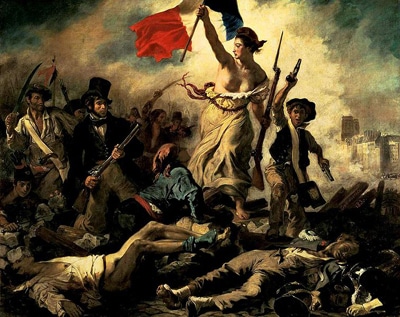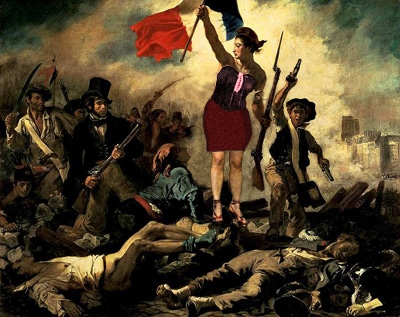by Merle Hoffman
| We asked leading thinkers to describe New Revolutions We Need for a feminist and progressive future. Here’s one response. |
Oscar Wilde, writing in The Soul of Man Under Socialism, said, “A map of the world that does not include Utopia is not worth glancing at, for it leaves out the one country at which Humanity is always landing.”
Unsurprisingly, women have been assigned supporting roles in even the most expansive male-imagined Utopias. Yet, modern day feminists seem to have lost the art of visionary mapmaking altogether.
The first voyager to Utopia was Plato, who in The Republic created a society that utilized the energies of all people. Women’s reproduction did not keep them from playing a citizenship role (children were to be raised communally). Plato insisted that women were capable of the same tasks as men, although he assumed they would be inferior in performing them.
Thomas Moore, writing hundreds of years later in Utopia, took the Platonic position of utilizing all citizens’ skills for the good of society. His vision was less progressive than Plato’s, but women were fully functioning members of society. Women farmed, learned trades, fought battles along with their husbands and were educated—a radical concept in 16th century England.
While women fared well-enough in these imaginative landscapes of male Utopias, their real-time lives continued to be subservient and powerless. War, poverty, violence, early death, discrimination and terror continued to create the contours of their existence.
When visionaries did manage to “land on Utopia,” it was usually a crash landing with multiple casualties.
The first major landing was the French Revolutionaries, who, in attempting to create a new world with “Reason” as their God left a landscape of headless corpses. The American Revolution, taking much of its philosophy from the French Enlightenment, made “life, liberty and the pursuit of happiness” the troika of its Utopian vision. Unfortunately, in Jefferson’s “workshop of liberty,” women and enslaved Blacks were completely left out.
Views of Feminist Revolution
Some early visionaries of the “feminist revolution” of the 20th century had a concept of a gender-neutral egalitarian society where women would be able to “be all they could be.”

Indeed, the rhetoric of the movement often stressed that a successful landing on this Utopia would be soft and benefit not only women, but also men and male institutions. Men would learn or be taught to welcome a radical change in their personal and political power positions.
The vision outlined in Betty Freidan’s 1963 book, The Feminine Mystique, said to have sparked the “second-wave” of feminism, was one of freedom from the “problem that had no name.” She saw the freedom to become a fully-engaged person as the “personal” and the goal of a gender-neutral society that would have no barriers to women’s self-fulfillment as the “political.”
Unlike the Civil Rights struggles of the 20th century that were triggered by attacks and assaults against African Americans, leaving a sordid trail of bloodshed, the feminist revolution did not emerge from violence, although terror and poverty crushed many women’s lives. Women’s biological and historical inheritance of bloodshed — through wars, rapes, domestic violence, botched childbirth and illegal abortions – remain a continual, though unanswered, scream for radical action.
Now, after so many years, we still have no collective vision of what feminism is or is not. If one can’t even name the boundaries or contours of the vision, or agree on what a feminist is, then we are left with feminism as a product. In a society where everything from sex to war and revolution is commodified, branded and packaged to sell, feminism is another box on the shelves.

Lost in Black Holes
Rather than vision, public discussion of feminism seems to be back in black holes of discussions about glamour and whether or not one can be a feminist and still wear high heels and lipstick. This is a conversation that can only exist in a society that has lost recognition of the role of visionaries: indeed, the greatest casualty of the feminist revolution may be the feminist vision itself.
A December 2008 article about feminism by Gemma Soames in England’s The Sunday Times quotes the founder of a feminist zine as saying “You can’t not buy shoes and wear dresses. Plus all of that stuff is fun — it doesn’t take away your power as a woman.”
Feminist Utopias have become personal spaces — spaces for lipstick or not; high heels or not; glamour; children, and dreams small enough to be accomplished by shopping, exercising or getting the right man or the right sperm.
According to Ellie Levenson, author of the soon-to-be-published The Noughtie Girls Guide to Feminism, quoted in the same article, “In the past, you had to subscribe to a whole set of beliefs to be a feminist, including how you should look and behave. But Noughties women have made it their own. It’s like a pick and mix feminism, where you can choose what you care about yourself.”
Ahh, the pleasure of the power of choice in a cafeteria of issue feminism where one works on what makes one happy – issues that are “relevant” to her. But the question remains: To what end do we empower ourselves and others? And, if, indeed, we have any “power as a woman,” what exactly is that to be used for?
Gender role and feminism revisited; a follow up study, published in 2006, showed that the majority of women and men identify themselves as feminists but they are unwilling to accept that label.
What does it mean when individuals say that they want women to have equal pay for equal work or have leadership positions by women, yet refuse to identify these goals as a part of the feminist vision or themselves as feminists? Or when the F word has so much power that women are loathe to use it. And this is on topics that are basic feminism 101: equal rights-equal pay.
What about true revolutionary goals of changing the power structure? Of changing the world from “what is” to “what should be”? If only the F word, which retains so much power to threaten, had the power to deliver the revolution at its core.
What’s in a name? A lot in this one, it seems.
The new cover of Ms. Magazine’s inauguration issue has Barack Obama in a Superman pose, opening his white shirt to reveal the tee shirt saying “This is what a feminist looks like.” And he is not even wearing lipstick or high heels!
Phoebe Feingold, editor of the “feminist fashion zine” Pamflet, told The Sunday Times that “There are so many people out there who wouldn’t describe themselves as feminists, but they blatantly are in their actions. They’re just scared of the word.” But what are the actions she is describing? Are they airlifting victims of male terror out of Africa? Setting up rape crisis shelters or rescuing girls from forced sexual slavery? They don’t dare call themselves feminists, so how could we possibly tell that they are?
Kate Roiphe is quoted in the same column as saying, “One of the most unappealing things about the feminist movement right from its inception was its tendency to judge other women.” Apparently, calling oneself a feminist might signal to the world that the person has a judgmental standard of right and wrong, and feminist and non-feminist. And why not pass judgment on a “new brand of feminism” whose agenda is a heady brand of consumerism and adolescent self-involvement.
It appears that by calling yourself a feminist, you may have people believe that your concerns transcend the presentation of self to a vision of others and to politically important issues. You may even appear to want to have real power, not merely the celluloid kind with the trappings of celebrity and fame.
There is still a great deal of work to do. Even the initial goals of the early feminists for a gender-neutral egalitarian society, equal rights, and equal pay for equal work have not been achieved, while legal abortion continues to be under assault. We have a very long road to travel to even come close to building a new society or overthrowing male privilege.
In this year of 2009, as we celebrate ourselves for overcoming one of our nation’s birth defects with the election of a Black president, the question remains: What is feminism and what is the feminist vision?
At the very least, any feminist vision depends on critical judgments of oneself and society. It means the creation of a collectively-imagined country, if you will, that we all want to land on — one in which immigration is not limited to those in high heels. If, in this Utopia, all discrimination against women is abolished, we might be forced to think of the good of the whole instead of the one, and accept the reality that power will change hands, minimizing or abolishing altogether male privilege and entitlements.
But we need visionaries who must hold us to those higher standards and take the longer view than what is immediately available or possible. We must learn to want to do the impossible. The visionary is one who dreams of the world that “should be,” mapping the landscapes and focusing our sights. We also may make a crash landing — but we have to get off the ground first.
Merle Hoffman
Publisher and Editor-in-Chief
For more Merle Hoffman Editorials
Merle Hoffman is the Publisher and Editor-in-Chief of On The Issues Magazine. She is the Founder, President and CEO of CHOICES Women’s Medical Center.
